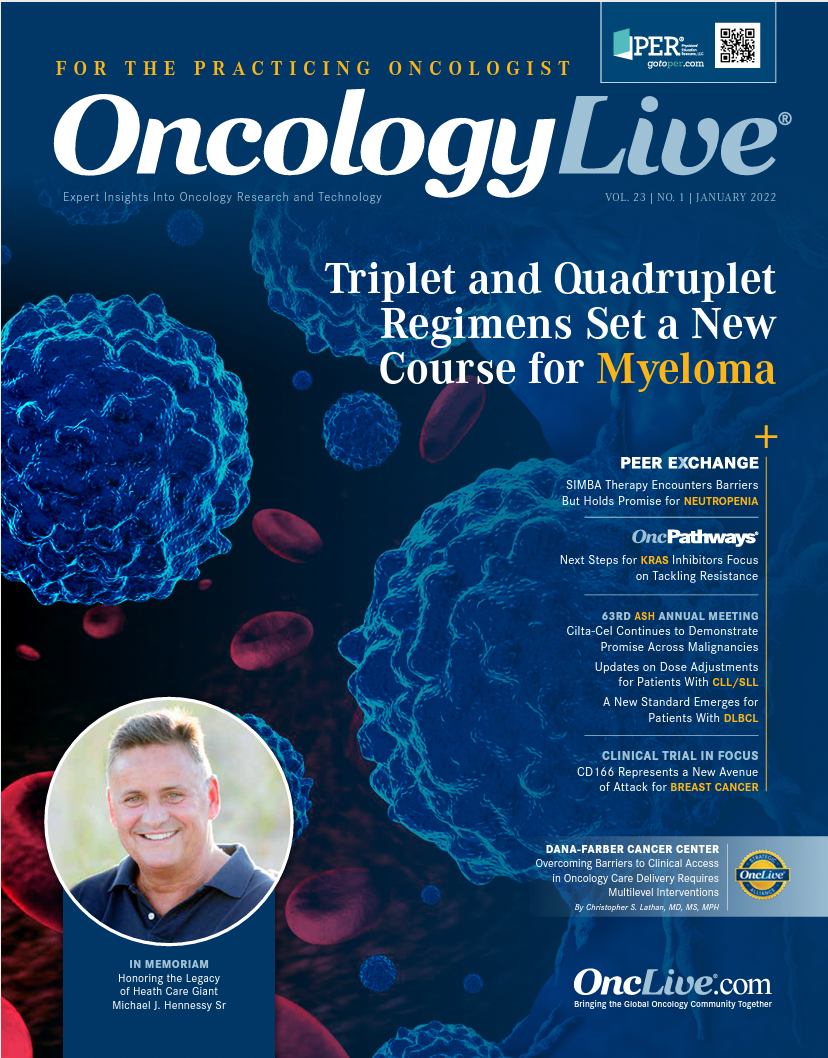Publication
Article
Oncology Live®
SIMBA Therapy Encounters Barriers But Holds Promise for Neutropenia and Beyond
Author(s):
Hope S. Rugo, MD, FASCO, Rita Nanda, MD, William J. Gradishar, MD, and Tiffany A. Traina, MD discuss the selective immunomodulating microtubule-binding agent plinabulin, plus several other novel chemoprotective therapies under exploration, including trilaciclib.
Hope S. Rugo, MD

Cytotoxic chemotherapy can cause significant and sometimes prolonged neutropenia, often increasing the risk of hospitalization and life-threatening infections. To reduce the risk of these complications, which can lead to poor outcomes, prophylactic granulocyte colony-stimulating factors (G-CSFs) are used, but these agents can be burdensome to administer and have toxicities such as bone pain that can affect patients’ quality of life. A novel agent has emerged that shows promise in addressing these challenges: a selective immunomodulating microtubule-binding agent (SIMBA) called plinabulin. “Not only does it affect progenitors that can affect the blood counts, but it may also have an anticancer effect,” William J. Gradishar, MD, said during a recent OncLive Peer Exchange®.
Gradishar was joined by a panel of breast cancer experts who discussed plinabulin, including some promising data from several clinical trials, including the pivotal phase 3 PROTECTIVE-2 trial (NCT03294577).1 “It would be nice to give all the medication on the same day and have good control without worrying about a drug not working or how many doses of short-acting growth factor to give and when,” said Hope S. Rugo, MD, FASCO. Based on the positive data, plinabulin was under review with the FDA at the time of the Peer Exchange; however, the FDA recently issued a complete response letter (CRL) requesting an additional trial before the agent could be approved for chemotherapy-induced neutropenia (CIN).2
In addition to reviewing plinabulin, the panelists briefly discussed several other novel chemoprotective therapies under exploration, including trilaciclib (Cosela), which was recently approved to reduce chemotherapy-induced bone marrow suppression in patients with extensive-stage small cell lung cancer (SCLS).3
Hurdles Delay Approval of Plinabulin
On December 1, 2021, the FDA issued a CRL to BeyondSpring Pharmaceuticals’ new drug application (NDA) for approval of plinabulin in combination with G-CSF to prevent CIN.2 The CRL indicated that the results of PROTECTIVE-2 were “not sufficiently robust to demonstrate benefit and that a second well-controlled trial would be required to satisfy the substantial evidence requirement to support the CIN indication.” The rejection was surprising and it has been reported that it may have resulted from an early miscommunication between BeyondSpring and the FDA.4 Although the NDA focused on data from the phase 3 PROTECTIVE-2 trial, it also included data from 5 supportive trials that collectively enrolled over 1200 patients; however, the FDA considered only the phase 3 data and deemed it insufficient. In contrast, BeyondSpring anticipated that all included data would be considered.
In a news release announcing the FDA’s decision, BeyondSpring did not commit to a second study but said it “expects to work closely with the FDA to consider the possible future clinical pathway for CIN, which may include a second study.”2 Analysts anticipate that a meeting between BeyondSpring and the FDA will occur early next year.4 Discussions to file a new application for approval in non–small cell lung cancer (NSCLC) are also planned based on data from the DUBLIN-3 trial (NCT02504489).4,5
Mechanism of Action and Administration
Plinabulin is a SIMBA, which is a potent antigen-presenting cell inducer.2 “Not only is it capable of potentially preventing the deep neutropenia that we see in some patients, but it also may have an effect on the immune system,” Gradishar said. He explained that plinabulin binds to microtubules and releases the protein GEF-H1, activating the signaling pathway. Once that pathway is activated, there is a maturation of dendritic cells, which then present the antigen to the T cells, leading to their activation.
“Before we had the acronym SIMBA, we were focusing more on the properties that affected blood counts, specifically, the intensity and depth of neutropenia. In one of the clinical trials [it was] suggested that there was indeed an antitumor effect, which broadened the acronym to take that into account,” he said.
Because of plinabulin’s dual action in prevent-ing neutropenia and potentially exerting antitumor effects, the panelists expressed interest in learning how this agent may interact with certain anticancer treatments down the road, particularly checkpoint inhibitors. “It’s so fascinating that a drug that’s been developed for neutropenia could also have other effects that could potentially affect the efficacy of the agents that we’re using by helping the immune system recognize tumor cells,” Rita Nanda, MD, said.
Plinabulin is given as a single dose per chemo-therapy cycle via a 30-minute intravenous (IV) infusion. It is administered on the same day, 30 minutes after the chemotherapy dose.
Clinical Trials
The panelists’ discussion focused on 3 trials that evaluated plinabulin: the phase 2/3 PROTECTIVE-1 trial (NCT03102606),6 the pivotal phase 3 PROTECTIVE-2 trial,1 and the phase 3 DUBLIN-3 trial.5
PROTECTIVE-1
PROTECTIVE-1 is a global, multicenter, double-blind trial that randomly assigned 105 patients with breast, lung (NSCLC), or hormone-refractory prostate cancer 1:1 to receive 4 cycles of docetaxel 75 mg/m2 plus placebo on day 1 and pegfilgrastim 6 mg on day 2 (n = 53) or docetaxel 75 mg/m2 plus plinabulin 40 mg on day 1 and placebo on day 2 (n = 52).6 “The small study was designed as a noninferiority trial to look at days of severe neutropenia, and built into the trial were almost daily CBCs [complete blood counts] and tracking of the neutrophil count,” Tiffany A. Traina, MD, said.
The study met its primary end point, with significantly fewer days of neutropenia in the plinabulin arm vs the pegfilgrastim arm. Severe neutropenia was defined as absolute neutrophil count of less than 0.5 cells × 109/L. The mean duration of severe neutropenia (DSN) in cycle 1 was 0.246 days in the pegfilgrastim arm (95% CI, 0.205-0.287), compared with 0.770 in the plinabulin arm (95% CI, 0.682-0.857).6 Several secondary end points also favored plinabulin.
Traina said another advantage in the plinabulin arm was significantly less bone pain and less thrombocytopenia. “I don’t know if that was anticipated, but it was observed,” she added. Overall, plinabulin was well tolerated, with a comparable safety profile to pegfilgrastim. Traina noted that the most common adverse effects (AEs) included low-grade infusion reactions and gastrointestinal toxicity, including nausea, diarrhea, and fatigue. “It can be potentially hard to tease out what is related to docetaxel, given that both arms are receiving backbone chemotherapy, but it did appear well tolerated,” Traina said.
Nanda and Gradishar pointed out that the PROTECTIVE-1 study shows several benefits of single-agent plinabulin over single-agent pegfilgrastim. These include its ease of use and reduced risk of thrombocytopenia, which is another major concern with chemotherapy, particularly platinum agents, and a reduction in patients experiencing bone pain. “When we talk about effects of these drugs, we’re usually worried about the pleiotropic effect or the off-target effect, Gradishar said. “What we’re describing here is a drug that is pretty well tolerated, easy to give, and the off-target effects are favorable for the patient regarding neutropenia and a potential anticancer effect. Right now, it looks like a very favorable kind of drug to be using.”
PROTECTIVE-2
The PROTECTIVE-2 study assessed whether combining plinabulin with pegfilgrastim could be beneficial. “One rationale for putting these 2 agents together, plinabulin plus pegfilgrastim, would be more of the continuous protection against neutropenia throughout that intercycle duration,” Traina said. Data show that plinabulin mainly exerts its CIN preventive effects in week 1 of the cycle when more than 75% of clinical complications occur.6 In contrast, G-CSFs such as pegfilgrastim primarily exert their CIN-preventive effects during week 2 of the cycle.6 “We still get that [absolute neutrophil count] nadir, and then we get quicker recovery,” she said.
PROTECTIVE-2 is a global, multicenter, double-blind trial that randomly assigned 221 patients with ECOG scores of 0 or 1 who were receiving docetaxel 75 mg/m2, doxorubicin (50 mg/m2), and cyclophosphamide (500 mg/m2), a regimen known as TAC, to receive either plinabulin (40 mg) plus pegfilgrastim (6 mg) or pegfilgrastim (6 mg) plus placebo.1 “Lack of grade 4 neutropenia was the primary end point,” Trina said.
She noted that PROTECTIVE-2 met its primary end point. In data presented that the 2021 American Society of Clinical Oncology Annual Meeting, investigators showed that among the 110 patients in the plinabulin/pegfilgrastim arm 31.53% were protected from grade 4 neutropenia vs 13.64% of those treated with pegfilgrastim alone (n = 111) in cycle 1 (P = .0015). As in PROTECTIVE-1, several secondary end points were clinically meaningful. Febrile neutropenia was observed in 3.60% of patients treated with the combination vs 6.36% of patients treated with pegfilgrastim alone through cycle 4 (P = .36).1
Additionally, when considering cases of profound neutropenia, measured as an absolute neutrophil count of 100 per μL, the combination treatment improved clinical benefit by close to 50%. The median duration of febrile neutropenia with the combination was 1.25 days, compared with 2.28 days with pegfilgrastim alone. The rates of hospitalization were 75% with the combination vs 100% with pegfilgrastim alone and the median duration of hospitalization was 3.75 days vs 7.14 days, respectively. The administration of plinabulin/pegfilgrastim resulted in 2.7% of patients adjusting the chemotherapy dose and/or regimen in later cycles, compared with 6.3% of patients who received pegfilgrastim alone.1
Traina said bone pain was also reduced with the combination. Patients who received the combination experienced bone pain at a frequency of 18%, compared with 30% among those who received pegfilgrastim alone (P = .03).1 “It’s certainly more comfortable for our patients,” Traina said.
Another exciting finding Traina highlighted was that overall incidence of grade 4 events was significantly lower in the combination arm. “Plinabulin plus pegfilgrastim had 20% lower grade 4 adverse events with TAC compared with TAC plus pegfilgrastim. It seems to be having an effect beyond just affecting the neutrophil count,” she said.
Nanda said she has not used TAC in many years, noting that it is a challenging regimen for patients, making any agent that can help with tolerability welcomed. “I think an improvement in quality of life in addition to the reduction of AEs and chemotherapy-induced neutropenia and febrile neutropenia is a home run,” she said, adding that she is interested in seeing whether plinabulin may have benefit in the setting of other difficult-to-tolerate chemotherapy regimens, particularly those used in patients with early-stage triple-negative breast cancer.
DUBLIN-3
DUBLIN-3 is a phase 3, global, randomized, single-blind, active-controlled trial that included 559 patients with epidermal growth factor receptor wild type NSCLC with measurable lung lesions being treated in the second and third line. Patients were treated on a 21-day cycle with docetaxel 75 mg/m2 on day 1 and plinabulin 30 mg/m2 on days 1 and 8 or with docetaxel alone.5 Unlike PROTECTIVE-1 and PROTECTIVE-2, the primary end point was overall survival (OS).
The mean and median OS rates were significantly improved in the plinabulin arm. Additionally, OS rates doubled with plinabulin/docetaxel vs docetaxel alone at 24 months (22.13% vs 12.51%; P = .0072), 36 months (11.73% vs 5.27%; P = .0393), and 48 months (10.6% vs 0%; P value not determinable). Secondary end points favoring plinabulin/docetaxel over docetaxel alone included investigator-assessed overall response rate (12.23% vs 6.76%, respectively; P = .0275) and mean progression-free survival (6.0 vs 4.4 months, respectively; P = .0062).7
“The differences that were presented were modest, but to see an agent that not only prevents neutropenia but also has anticancer properties is pretty exciting,” Nanda said. “It is certainly worthy of additional investigation, particularly as we’re moving immunotherapy into the early-stage setting.”
Other Novel Chemoprotective Agents
A variety of other agents are being explored as prophylaxis against CIN. One such agent, trilaciclib, received FDA approval on February 12, 2021, to reduce the frequency of CIN in patients with small cell lung cancer.3 Approval was based on data from 3 randomized phase 2 trials that showed that use of G-CSFs, erythropoiesis-stimulating agents (ESAs), and red blood cell (RBC) transfusions on or after week 5 was significantly lower among patients receiving trilaciclib vs placebo (28.5% vs 56.3%, P < .0001; 3.3% vs 11.8%, P = .0254; and 14.6% vs 26.1%, P = .0252, respectively).8 Additionally, when severe neutropenia occurred, the duration was reduced in patients who received trilaciclib.
The panelists noted that trilaciclib is also being explored for breast cancer. “It did not show the same [benefit in reducing neutropenia] in breast cancer with a different chemotherapy backbone,” Rugo said. “It’s intriguing that these drugs may work differently based on the kind of chemotherapy backbone we have as well.”
Although the primary end point of a reduction in grade 4 neutropenia was not met in the trial, Rugo mentioned that in results from an ongoing phase 2 trial (NCT02978716) assessing the addition of trilaciclib to gemcitabine/carboplatin in women with triple-negative breast cancer, there was an unexpected positive finding.9 The investigators observed a 63% reduction in the risk of death (P < .0001) with the addition of trilaciclib.
"Other compounds are being investigated, including one that goes by the acronym ALRN-6924, which is a peptide that may also have a similar effect on preventing neutropenia,” Gradishar said. A phase 1b trial (NCT04022876) is assessing ALRN-06924 in preventing chemotherapy-induced AEs in patients with small cell lung cancer or NSCLC treated with carboplatin/pemetrexed. The trial is currently recruiting patients.10
References
- Blayney DW, Shi Y, Adamchuck H, et al. Clinical trial testing superiority of combination plinabulin (Plin) and pegfilgrastim (Peg) versus peg alone in breast cancer treated with high-risk febrile neutropenia risk chemotherapy (chemo): final results of the phase 3 protective-2 in chemo-induced neutropenia (CIN) prevention. J Clin Oncol. 2021;39(suppl 15):533. doi:10.1200/JCO.2021.39.15_suppl.533
- BeyondSpring Pharmaceuticals receives complete response letter from the FDA for plinabulin new drug application for prevention of chemotherapy-induced neutropenia (CIN). News release. Beyond-Spring Pharmaceuticals. December 1, 2021. Accessed December 6, 2021. bit.ly/3o9Y0ro
- FDA approves drug to reduce bone marrow suppression caused by chemotherapy. News release. FDA. February 12, 2021. Accessed December 6, 2021. bit.ly/31pO6cH
- Taylor NP. BeyondSpring lurches down as FDA rejects plinabulin, raising questions about lung cancer prospects. Fierce Biotech. December 3, 2021. Accessed December 6, 2021. bit.ly/3or3Api
- Han B, Shi YK, Feinstein T, et al. DUBLIN-3 (BPI-2358-103): a global phase (Ph) III trial with the plinabulin/docetaxel (Plin/Doc) combination vs. Doc in 2nd/3rd Line NSCLC patients (pts) with EGFR-wild type (wt) progressing on a prior platinum-based regimen. Ann Oncol. 2021;32(suppl 5):S1218-S1346. doi:10.1016/j.annonc.2021.08.2127
- Blayney DW, Shi Y, Bondarenko I, et al. Head-to-head comparison of single agent (SA) plinabulin (Plin) versus pegfilgrastim (Peg) for the prevention of chemotherapy-induced neutropenia (CIN) in the phase 3 trial PROTECTIVE-1. J Clin Oncol. 2021;39(suppl 15):547. doi:10.1200/JCO.2021.39.15_suppl.547
- BeyondSpring announces positive topline results from its DUBLIN-3 registrational trial of plinabulin in combination with docetaxel for the treatment of 2nd/3rd line non-small cell lung cancer (NSCLC) with EGFR wild type. News release. BeyondSpring Pharmaceuticals. August 4, 2021. Accessed December 6, 2021. bit.ly/331tHuJ
- Ferrarotto R, Anderson I, Medgyasszay B, et al. Trilaciclib prior to chemotherapy reduces the usage of supportive care interventions for chemotherapy-induced myelosuppression in patients with small cell lung cancer: pooled analysis of three randomized phase 2 trials. Cancer Med. 2021;10(17):5748-5756. doi:10.1002/cam4.4089
- O’Shaughnessy J, Wright GS, Thummala AR, et al. Trilaciclib improves overall survival when given with gemcitabine/carboplatin in patients with metastatic triple-negative breast cancer: final analysis of a randomized phase 2 trial. Cancer Res. 2021;81(suppl 4):PD1-06. doi:10.1158/1538-7445.SABCS20-PD1-06
- A study of ALRN-6924 for the prevention of chemotherapy-induced side effects (chemoprotection). ClinicalTrials.gov. Updated July 1, 2021. Accessed December 6, 2021. https://clinicaltrials.gov/ct2/show/NCT04022876




















%20(2)%201-Recovered-Recovered-Recovered-Recovered-Recovered-Recovered-Recovered-Recovered-Recovered-Recovered-Recovered-Recovered-Recovered-Recovered-Recovered-Recovered-Recovered.jpg?fit=crop&auto=format)
%20(2)%201-Recovered-Recovered-Recovered-Recovered-Recovered-Recovered-Recovered-Recovered-Recovered-Recovered-Recovered-Recovered-Recovered-Recovered-Recovered-Recovered-Recovered.jpg?fit=crop&auto=format)
